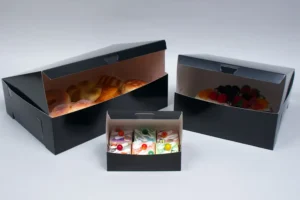
The global food and beverage industry is undergoing a transformation shaped by changing consumer preferences, technological advances, and shifting economic dynamics. In a market influenced by health consciousness, sustainability concerns, and digital innovation, brands must be nimble, informed, and forward-thinking. As 2025 approaches, companies that embrace emerging opportunities will be best positioned for long-term success.
According to recent food and beverage industry analysis, demand is rising for functional foods, plant-based alternatives, sustainable packaging, and personalized nutrition. These trends reflect a consumer base that wants more than just convenience—they’re seeking products that align with their health goals, values, and lifestyles.
In this blog, we’ll explore some of the top growth opportunities that food and beverage brands can tap into globally, along with strategies to leverage these trends for competitive advantage.

1. Plant-Based and Alternative Proteins
Plant-based foods have moved beyond niche status and are now a mainstream expectation, especially among Millennials and Gen Z consumers. From meat substitutes to dairy-free beverages, the appetite for alternative proteins continues to expand. According to industry forecasts, the plant-based food market could exceed $75 billion globally by 2030.
Key drivers include:
Rising health awareness
Environmental and animal welfare concerns
Improved taste and texture of plant-based products
Brands can seize this opportunity by investing in innovative ingredients like pea protein, mycelium, lentils, and chickpeas. Also, regional flavors and local ingredient sourcing can create unique offerings that resonate with diverse markets.
2. Functional and Fortified Foods
Consumers are increasingly looking for food and beverages that provide more than basic nutrition. Functional products that support immunity, gut health, sleep, energy, and mental clarity are in high demand. This has opened new doors for fortification with vitamins, adaptogens, nootropics, and probiotics.
Popular examples include:
Beverages with added electrolytes or collagen
Snack bars enhanced with magnesium or fiber
Yogurts with probiotics and prebiotics
Functional teas with mood-boosting herbs like ashwagandha or chamomile
Food and beverage industry analysis shows that the functional food segment is expected to grow faster than traditional categories, making it a promising area for innovation.
3. Personalized Nutrition and Data-Driven Products
The future of food is personal. With wearable tech, mobile apps, and DNA testing becoming more accessible, consumers are starting to expect personalized recommendations and products tailored to their unique needs.
Whether it’s meal kits customized to dietary restrictions or beverages tailored to fitness goals, personalization offers a way to build deep consumer loyalty. Companies can leverage AI and big data to create custom products, subscription services, or digital platforms that evolve with the user’s lifestyle.
Smart packaging and QR code integrations also allow brands to track consumer feedback and offer personalized nutrition insights post-purchase.
4. Sustainable and Ethical Sourcing
Sustainability is no longer a differentiator—it’s a requirement. Modern consumers want to know the story behind their food, from farm to table. Transparency around sourcing, labor practices, and environmental impact influences purchase decisions more than ever.
Opportunities in this space include:
Upcycled ingredients to reduce food waste
Regenerative agriculture partnerships
Carbon-neutral and eco-friendly packaging solutions
Certifications like Fair Trade, Rainforest Alliance, and B Corp
Brands that take meaningful steps toward sustainability—and communicate those efforts clearly—can gain a competitive edge. Many CPG companies are also integrating sustainability into their new product launch strategy, ensuring that every innovation aligns with ESG (Environmental, Social, and Governance) goals.

5. Global Flavors and Cultural Fusion
As global connectivity increases, so does interest in diverse culinary experiences. Consumers are eager to explore international cuisines and ingredients, from Korean gochujang and Japanese yuzu to West African fonio and Peruvian maca.
This presents an exciting opportunity for brands to:
Introduce global fusion products
Collaborate with chefs and culinary influencers
Create regionally inspired limited editions
Launch localized products in international markets
Globalization also provides a chance to tap into underserved markets in Southeast Asia, Africa, and Latin America, where rising disposable incomes and urbanization are boosting demand for packaged food and beverages.
6. Better-for-You Snacks and Convenience Foods
Even as health awareness grows, convenience remains a top priority. Busy lifestyles and on-the-go habits are fueling demand for snacks that are not only quick but also nutritious.
Opportunities include:
Protein-packed snacks
Low-sugar and low-carb alternatives
Clean-label, single-serve meals
Air-fried and baked snack chips as healthier indulgences
These trends offer excellent potential for product expansion, especially for companies with strong new product launch strategy frameworks. Success depends on balancing taste, nutrition, and shelf-life while keeping production costs under control.
7. E-commerce and Direct-to-Consumer (DTC) Channels
Digital transformation has reshaped how consumers discover, purchase, and interact with food and beverage brands. With online grocery shopping and DTC models growing, companies must optimize their presence across e-commerce platforms, social media, and mobile apps.
Top opportunities in this area include:
Subscription-based delivery services
Bundled products and value packs
Limited-edition or influencer-collaborated product drops
Real-time feedback and product reviews for rapid improvement
DTC allows brands to build deeper customer relationships, access first-party data, and improve margins by bypassing traditional retail distribution.
Conclusion
The global food and beverage market is rich with opportunity—if you know where to look and how to act. Whether you’re focused on plant-based innovation, sustainability, global expansion, or personalized nutrition, the key is to align your offerings with emerging consumer values and technological advancements.
A data-driven food and beverage industry analysis provides the clarity needed to identify high-potential segments, while a well-structured new product launch strategy ensures that your innovations make a strong market impact. In this dynamic landscape, the most successful brands will be those that blend agility, authenticity, and insight—creating not only products, but experiences that resonate.
As the industry continues to evolve, growth will come to those who innovate with purpose, understand their consumers deeply, and act quickly on the signals shaping tomorrow’s food culture.

